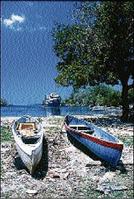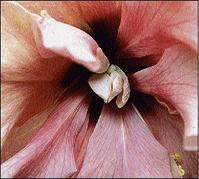Howard Moo Young, Gleaner Writer 
The vertical format, with the use of a wide-angle lens, created this perfect composition of boats resting in Scott's Cove on the border of St Elizabeth and Westmoreland. A polarising filter helped to create better saturation of sky and vegetation.
The speed and ease of pressing the shutter release on a modern camera can be a stumbling block to imaginative photography, unless you recognise that most of the work involved in creating a picture should be done beforehand.
You can produce effective images unerringly, rather than by chance, by applying principles of composition that depend on close observation of the subject in the viewfinder these principles necessarily relate more to still subjects than to action pictures, they can help all aspects of your photography.
Whenever you plan a photograph, look long and hard at the subject until you are aware of every single aspect and detail from edge to edge of your viewfinder. Then analyse what you see. Decide on the strongest point of interest, the aspect of the scene that first caught your attention. How can you make this feature prominent? Which other elements support the main feature, and where should they be placed to balance or add drama to the picture as a whole? Composition can become first a logical and controlled process, and eventually a natural way of seeing better pictures.
WAYS OF SEEING

This 'old-timer' was the subject of this pleasant portrait as he took part in the annual Potters Fair, two years ago. A zoom lens was used with natural light.
Ask a number of people to describe the same scene and you will get a different response from each of them. Similarly, a group of photographers asked to take pictures of the same subject will produce very different images.
Whenever you are out shooting, you might want to choose a subject that represents an image that is easily recognisable. It might be a familiar landmark, a building, a piece of sculpture, a park, a market, an individual face, groups of people, an unusual setting, animals, garbage, commuters taking buses or robot taxi drivers arguing with the police, etc. Each individual will see the subject differently, and while the camera may seem to record the world objectively, the photographer always subjectively decides where the camera will look.
Being aware of your subjective reactions to a scene can help you to compose better photographs. Before you begin to set up a picture, try to decide what stimulated your interest in a scene. When you know why you want to take a photograph, you can go on to analyse the pictorial elements in the subject and decide the best way to portray them.
CHOOSING THE BEST VIEWPOINT
Changing the viewpoint is a photographer's most important means of controlling the way the picture will look. Sometimes moving the camera only slightly can transform the whole composition. Indeed, one of the easiest ways to improve your pictures is to make a habit of moving around the subject to find the best camera position whenever you spot something you wish to photograph. Look out for different backgrounds as you move around, and the way the lighting changes the mood.
Seen from a level camera position, most scenes consist of a foreground, a middle distance and a background. The relative positions of objects on these planes can be altered dramatically by shifting the viewpoint. Imagine a scene with a field in the foreground, a house in the middle distance, and a tree behind it in the background. Simply by moving your camera to the right, you place the house to the left of the tree. A lower viewpoint might bring flowers in the field into the close foreground; a higher view would reduce the amount of sky in the frame. By moving back, you could make the house appear smaller and perhaps bring extra foreground elements, such as an overhanging branch of a tree into the photograph.
Only by exploring all the possible viewpoints before taking a picture can you hope to arrive at the best one. Of course, any subject may present you with a number of good viewpoints, all of which will produce equally satisfactory images. Then, your choice must depend on the aspects of the scene you find most interesting. An excellent way to learn both the techniques of composition and the particular approaches to a subject that suit you is to take a series of photographs from different positions and then compare the results. With the advent of the digital camera, this exercise is much easier than the amount of film I've used up in the past to gain these insights, but at the same time, I didn't consider it a waste of film, but a learning experience.
THE VIEW THROUGH THE LENS

A leaf of a Trinidad fern was set against a dark background, lit by the sun, to show the details that I wanted to capture in this image. A macro-lens and tripod were used.
A change of viewpoint always leads to a change in the appearance of a picture, but there is another way to alter the composition without moving to a different position. This is to replace the camera's normal lens with one of a shorter or longer focal length - a wide-angle, zoom or telephoto lens. If your camera has a built-in zoom lens, so much the better.
If you change lenses on a SLR, the effects in the viewfinder are dramatic. With a telephoto lens, the view contracts in scope but enlarges in scale. With a wide-angle lens, the view broadens but objects within it appear to reduce in size. However, the lens you use affects the image in other, more, subtle ways. A wide-angle lens encourages you to move closer, to form a bigger image of nearby subjects. Since moving in closer does little to change the apparent size of distant objects, a wide-angle lens seems to expand a picture's sense of depth; close subjects seem even nearer, while distant ones appear farther away than they actually are.
This change in the relative sizes of near and far-off objects opens up a multitude of different choices in composing the image. For example, you can relate to the foreground and background of the picture in a way that is impossible with a normal lens.
A telephoto lens has very different influences on the way you compose images. Its narrow angle of view compels you to choose extremely carefully the part of the subject you want to show. At the same time, the magnifying effect encourages you to stand farther away from a subject. When you are looking at a small selected area from a distant viewpoint, nothing looks the same as it does from nearby. The telephoto lens seems to compress perspective and stack objects on top of one another. In this way, the lens supplies a valuable way of translating three-dimensional subjects into the two-dimensional language of photography. You can use it to reduce the sensation of depth and compose pictures in which familiar objects become bold shapes and strident patterns, or to make arresting pictures from small subject details that would normally pass unnoticed in a broader view.
DECIDING THE FORMAT

An extreme close-up of a triple peach hibiscus taken in my garden with the use of a macro-lens and natural light. A tripod was used for support. - Howard Moo Young Photos
Usually one of the major decisions a photographer must make is whether to hold the camera horizontally or vertically. You do not face the choice with cameras that provide a square image. But with a normal 35-mm camera, the proportions of the frame are strongly rectangular, and the positioning of this frame is often crucial in terms of both composition and content.
Because holding a camera horizontally is easier than holding it vertically, novices frequently take pictures this way without really considering the alternative. Of course, some subjects naturally suggest a vertical picture - e.g. full-length figures, towers, tall buildings and trees. However, even with these subjects there are situations in which you can compose the picture as either a horizontal or an upright image.
Horizontal pictures usually create a more static, peaceful effect than do vertical images, which psychologically suggest vigour - the overcoming of gravity. Sometimes the best images are those that run counter to our expectations. Photographers refer to landscape format to mean a horizontal picture, and portrait format to denote an upright one. Yet, a vertically composed landscape may bring interesting foreground or background details into the frame, and a horizontal portrait may be highly effective.
I do hope that as you continue to find ways to improve your photography, you will take the time to observe, move around, change positions from high to low viewpoint, look out for a change in lighting, exercise patience, and wait for that precise moment of decision in pressing the shutter. These are just a few tips that I will leave with you from time to time with these articles, and hope that you will learn from you own experiences.
Howard Moo Young is a graduate of the School of Visual Arts, New York, and is an advertising/graphic design/photography consultant with over 40 years experience. Email: mooimages@yahoo.com

